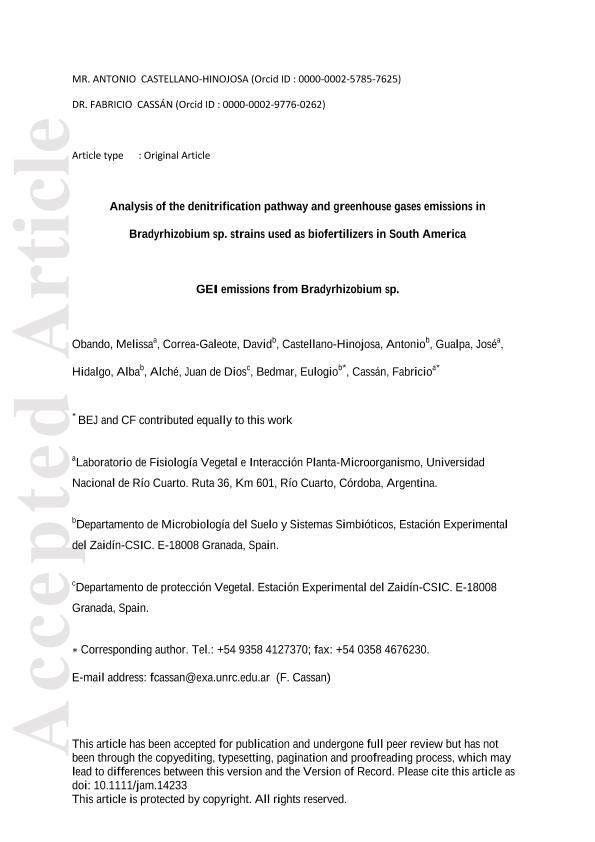Mostrar el registro sencillo del ítem
dc.contributor.author
Obando Castellanos, Dolly Melissa

dc.contributor.author
Correa-Galeote, David
dc.contributor.author
Castellano-Hinojosa, Antonio
dc.contributor.author
Gualpa, José Luis

dc.contributor.author
Hidalgo, Alba
dc.contributor.author
de Dios Alché, Juan
dc.contributor.author
Bedmar, Eulogio
dc.contributor.author
Cassan, Fabricio Dario

dc.date.available
2020-08-25T14:56:20Z
dc.date.issued
2019-06
dc.identifier.citation
Obando Castellanos, Dolly Melissa; Correa-Galeote, David; Castellano-Hinojosa, Antonio; Gualpa, José Luis; Hidalgo, Alba; et al.; Analysis of the denitrification pathway and greenhouse gases emissions in Bradyrhizobium sp. strains used as biofertilizers in South America; Wiley Blackwell Publishing, Inc; Journal of Applied Microbiology; 127; 3; 6-2019; 739-749
dc.identifier.issn
1364-5072
dc.identifier.uri
http://hdl.handle.net/11336/112320
dc.description.abstract
Aims Greenhouse gases are considered potential atmospheric pollutants, with agriculture being one of the main emission sources. The practice of inoculating soybean seeds with Bradyrhizobium sp. might contribute to nitrous oxide (N2O) emissions. We analyzed this capacity in five of the most used strains of Bradyrhizobium sp. in South America. Methods and Results We analyzed the denitrification pathway and N2O production by B. japonicum E109 and CPAC15, B. diazoefficiens CPAC7, and B. elkanii SEMIA 587 and SEMIA 5019, both in free‐living conditions and symbiosis with soybean. The in silico analysis indicated the absence of nosZ genes in B. japonicum and the presence of all denitrification genes in B. diazoefficiens strains, as well as the absence of nirK, norC and nosZ genes in B. elkanii. The in planta analysis confirmed the N2O production under saprophytic conditions or symbiosis with soybean roots nodules. In the last case up to 26·1 and 18·4 times higher in plants inoculated with SEMIA5019 and E109 respectively, than in those inoculated with USDA110. Conclusions The strains E109, SEMIA 5019, CPAC15 and SEMIA 587 showed the highest N2O production both as free‐living cells and in symbiotic conditions in comparison with USDA110 and CPAC7, which do have the nosZ gene. Although norC and nosZ could not be identified in silico or in vitro in SEMIA 587 and SEMIA 5019, these strains showed capacity to produce N2O in our experimental conditions. Significance and Impact of Study This is the first report to analyze and confirm the incomplete denitrification capacity and N2O production in four of the five most used strains of Bradyrhizobium sp. for soybean inoculation in South America.
dc.format
application/pdf
dc.language.iso
eng
dc.publisher
Wiley Blackwell Publishing, Inc

dc.rights
info:eu-repo/semantics/openAccess
dc.rights.uri
https://creativecommons.org/licenses/by-nc-sa/2.5/ar/
dc.subject
Greenhouse gases
dc.subject
Denitrification
dc.subject
Bradyrhizobium
dc.subject
Inoculants
dc.subject.classification
Biología Celular, Microbiología

dc.subject.classification
Ciencias Biológicas

dc.subject.classification
CIENCIAS NATURALES Y EXACTAS

dc.title
Analysis of the denitrification pathway and greenhouse gases emissions in Bradyrhizobium sp. strains used as biofertilizers in South America
dc.type
info:eu-repo/semantics/article
dc.type
info:ar-repo/semantics/artículo
dc.type
info:eu-repo/semantics/publishedVersion
dc.date.updated
2020-08-21T15:42:13Z
dc.identifier.eissn
1365-2672
dc.journal.volume
127
dc.journal.number
3
dc.journal.pagination
739-749
dc.journal.pais
Reino Unido

dc.journal.ciudad
Londres
dc.description.fil
Fil: Obando Castellanos, Dolly Melissa. Universidad Nacional de Río Cuarto. Facultad de Ciencias Exactas Fisicoquímicas y Naturales. Departamento de Ciencias Naturales. Laboratorio de Fisiología Vegetal y de la Interacción Planta-microorganismo; Argentina. Consejo Nacional de Investigaciones Científicas y Técnicas; Argentina
dc.description.fil
Fil: Correa-Galeote, David. Consejo Superior de Investigaciones Científicas. Estación Experimental del Zaidín; España
dc.description.fil
Fil: Castellano-Hinojosa, Antonio. Consejo Superior de Investigaciones Científicas. Estación Experimental del Zaidín; España
dc.description.fil
Fil: Gualpa, José Luis. Universidad Nacional de Río Cuarto. Facultad de Ciencias Exactas Fisicoquímicas y Naturales. Departamento de Ciencias Naturales. Laboratorio de Fisiología Vegetal y de la Interacción Planta-microorganismo; Argentina. Consejo Nacional de Investigaciones Científicas y Técnicas; Argentina
dc.description.fil
Fil: Hidalgo, Alba. Consejo Superior de Investigaciones Científicas. Estación Experimental del Zaidín; España
dc.description.fil
Fil: de Dios Alché, Juan. Consejo Superior de Investigaciones Científicas. Estación Experimental del Zaidín; España
dc.description.fil
Fil: Bedmar, Eulogio. Consejo Superior de Investigaciones Científicas. Estación Experimental del Zaidín; España
dc.description.fil
Fil: Cassan, Fabricio Dario. Universidad Nacional de Rio Cuarto. Facultad de Cs.exactas Fisicoquimicas y Naturales. Instituto de Investigaciones Agrobiotecnologicas. - Consejo Nacional de Investigaciones Cientificas y Tecnicas. Centro Cientifico Tecnologico Conicet - Cordoba. Instituto de Investigaciones Agrobiotecnologicas.; Argentina
dc.journal.title
Journal of Applied Microbiology

dc.relation.alternativeid
info:eu-repo/semantics/altIdentifier/url/https://sfamjournals.onlinelibrary.wiley.com/doi/abs/10.1111/jam.14233
dc.relation.alternativeid
info:eu-repo/semantics/altIdentifier/doi/https://doi.org/10.1111/jam.14233
Archivos asociados
